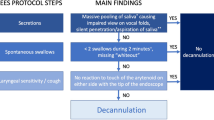Abstract
Purpose
Tracheoesophageal diversion (TED) is an effective therapeutic procedure for intractable aspiration. In this study, we performed TED in cases of intractable aspiration and/or repetitive pneumonia, investigated the main route of nutritional uptake after the procedure, and evaluated the swallowing method using videofluoroscopy. We also evaluated the validity of TED for treating intractable aspiration.
Methods
We retrospectively reviewed 44 patients (30 male and 14 female patients; median age, 55 years; range 15–85 years) who underwent TED for the treatment of intractable aspiration between January 2008 and December 2017. We examined the route of nutritional uptake before and after the operation and performed videofluoroscopy to detect the swallowing method after the operation.
Results
The percentage of patients with oral intake increased from 21% (9/44) before TED to 56% (25/44) within 1 month after TED (p < 0.01); this percentage included patients with poor preoperative swallowing function. Overall, 60% patients who were able to communicate and mobilize using a wheelchair as well as 92% patients who were able to communicate and mobilize in the supine position were able to consume food orally. We subsequently performed videofluoroscopy in 24 of the 25 patients with oral intake and assessed the passage route of the contrast agent, which was found to move through the laryngeal route in 54% of these patients.
Conclusion
TED may be suitable for the treatment of intractable aspiration and can improve oral intake, particularly in patients with good mobility and communication ability.

Similar content being viewed by others
References
Marik PE, Kaplan D (2003) Aspiration pneumonia and dysphagia in the elderly. Chest 124:328–336
Bartlett JG, Gorbach SL (1975) The triple threat of aspiration pneumonia. Chest 68:560–566
Lindeman RC (1975) Diverting the paralyzed larynx: a reversible procedure for intractable aspiration. Laryngoscope 85:157–180
Krespi YP, Quatela VC, Sisson GA, Som ML (1984) Modified tracheoesophageal diversion for chronic aspiration. Laryngoscope 94:1298–1301
Lindeman RC, Yarington CT, Sutton D (1976) Clinical experience with the tracheoesophageal anastomosis for intractable aspiration. Ann Otol 101:609–612
Baron BC, Dedo HH (1980) Separation of the larynx and trachea for intractable aspiration. Laryngoscope 90:1927–1932
Pletcher SD, Mandpe AH, Block MI, Cheung SW (2005) Reversal of laryngotracheal separation: a detailed case report with long-term followup. Dysphagia 20:19–22
Rosenbek JC, Robbins JA, Roecker EB, Coyle JL, Wood JL (1996) A penetration–aspiration scale. Dysphagia 11:93–98
Logemann JA (1993) Manual for the videofluorographic study of swallowing, 2nd edn. PRO-ED, Austin
Terry PB, Fuller SD (1989) Pulmonary consequences of aspiration. Dysphagia 3:179–183
Sasaki CT, Milmoe G, Yanagisawa E, Berry K, Kirchner JA (1980) Surgical closure of the larynx for intractable aspiration. Arch Otolaryngol 106:422–423
Umezaki T, Adachi K, Matsubara N, Lee Y (2018) Tracheoesophageal diversion and puncture operation for intractable aspiration: a case series. Laryngoscope 128:1791–1794
Habal MB, Murray JE (1972) Surgical treatment of life-endangering chronic aspiration pneumonia. Plast Reconstr Surg 49:305–311
Biller HF, Lawson W, Beak SM (1983) Total glossectomy. Arch Otolaryngol 109:69–73
Ku PK, Abdullah VJ, Vlantis AC, Lee KY, van Hasselt AC, Tong MC (2009) “Steam-boat” supraglottic laryngoplasty for treatment of chronic refractory aspiration: a modification of Biller’s technique. J Laryngol Otol 123:1360–1363
Eibling DE, Snyderman CH, Eibling C (1995) Laryngotracheal separation for intractable aspiration: a retrospective review of 34 patients. Laryngoscope 105:83–85
Eisele DW, Yarington CT Jr, Lindeman RC, Larrabee WF Jr (1989) The tracheoesophageal diversion and laryngotracheal separation procedures for treatment of intractable aspiration. Am J Surg 157:230–236
Kojima A, Imoto Y, Osawa Y, Fujieda S (2014) Predictor of rehabilitation outcome for dysphagia. Auris Nasus Larynx 41:294–298
Nakayama E, Tohara H, Hino T, Sato M, Hiraba H, Abe K, Ueda K (2014) The effects of ADL on recovery of swallowing function in stroke patients after acute phase. J Oral Rehabil 41:904–911
Adachi K, Umezaki T, Kiyohara H, Miyaji H, Komune S (2015) Clinical outcomes of tracheoesophageal diversion for intractable aspiration. J Laryngol Otol 129:69–73
Jungheim M, Schubert C, Miller S, Ptok M (2015) Normative data of pharyngeal and upper esophageal sphincter high resolution manometry. Laryngorhinootologie 94:601–608
Eisele DW, Yarington CT Jr, Lindeman RC (1988) Indications for the tracheoesophageal diversion procedure and the laryngotracheal separation procedure. Ann Otol Rhinol Laryngol 97:471–475
Funding
None.
Author information
Authors and Affiliations
Contributions
All authors contributed to the study conception and design. Material preparation and data collection and analysis were performed by KA, TU, and YK. The first draft of the manuscript was written by KA, and all authors commented on previous versions of the manuscript. All authors read and approved the final manuscript.
Corresponding author
Ethics declarations
Conflict of interest
The authors declare that they have no conflict of interest.
Ethical approval
All procedures performed in studies involving human participants were in accordance with the ethical standards of the institutional and/or national research committee (Kyushu University-certified institutional review board for clinical trials, number 15864) and with the 1964 Helsinki declaration and its later amendments or comparable ethical standards.
Informed consent
Informed consent was obtained from all individual participants included in the study.
Additional information
Publisher's Note
Springer Nature remains neutral with regard to jurisdictional claims in published maps and institutional affiliations.
Rights and permissions
About this article
Cite this article
Adachi, K., Umezaki, T., Matsubara, N. et al. Tracheoesophageal diversion improves oral uptake of food: a retrospective study. Eur Arch Otorhinolaryngol 277, 2293–2298 (2020). https://doi.org/10.1007/s00405-020-05988-8
Received:
Accepted:
Published:
Issue Date:
DOI: https://doi.org/10.1007/s00405-020-05988-8




